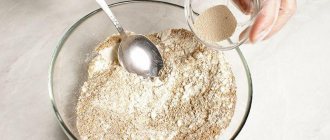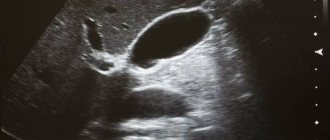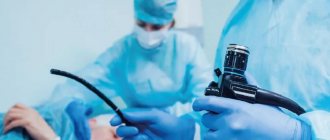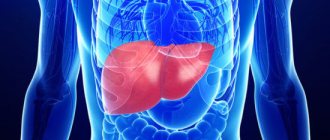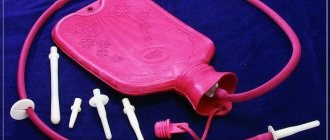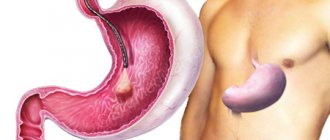Types of enemas
Cleansing enema Cleansing enemas are used to liquefy and remove gases and contents of the lower parts of the colon. The injected liquid has a mild mechanical, chemical and thermal effect on the large intestine, which enhances its peristalsis, dilutes stool and promotes its rapid and easy excretion. Siphon enema Siphon enema is used for repeated intestinal lavage in cases where a cleansing enema does not bring the desired result. The principle of the siphon enema is based on the law of communicating vessels, causing rhythmic contraction of the intestinal walls. Medicinal enema A medicinal enema is used to inject a small amount of medication into the patient's rectum. As a rule, these are sedatives, sleeping pills, and anti-inflammatory drugs. However, recently such enemas are used less and less, since most medications are now available in the form of suppositories. In the case of using a medicinal enema, a preliminary cleansing enema is required. Nutrient enema Nutrient enema is used when it is necessary to introduce nutrients through the rectum. In the lower part of the large intestine, proteins, various vitamins, amino acids, glucose, and aqueous solutions are absorbed, and therefore this method is also used in artificial nutrition of patients. Diagnostic enema This type of enemas is used to confirm or refute the presence of certain diseases in a patient. Diagnostic enemas include contrast enemas, which are done for x-ray examination of the large intestine. In this case, radiopaque contrast agents are injected into the large intestine.
Staging technique
To perform a cleansing enema, you will need an Esmarch rubber mug and approximately 1-1.5 liters of warm water. To improve the liquefaction of feces, you can add a little glycerin or any vegetable oil to the water.
The can must be filled with the prepared composition, the tip must be lubricated with baby cream or Vaseline. The patient lies on the couch, on his left side, with his legs bent and slightly pulled towards the body, after which the tip is carefully inserted into the anus. There should not be any uncomfortable or painful sensations.
After inserting the canister into the anus, the liquid is injected into the rectal cavity with soft, leisurely movements, then the tip of the rubber canister is carefully removed. The patient must try to hold the liquid in himself for at least 10-15 minutes, after which he can go to the toilet.
Other types of procedures are performed in the same way - the differences are only in the volume of the drug administered. For example, in the case of an oil enema, it is quite enough to introduce 100-200 ml of oil at room temperature into the body. After just 15 minutes, a person can go to the toilet to have a bowel movement.
Things to remember
Every person who has heard about the benefits of cleansing or other enemas should remember that in any case this is a medical procedure that is strictly not recommended to be carried out on your own.
The use of Esmarch's mug is permitted only in exceptional cases - when there is a serious need for it. Carrying out the procedure on your own and regularly is strictly not recommended, as this can cause serious harm to the body.
During the procedure, care must be taken to carefully follow all antiseptic rules - the tip of the rubber can must be sterile. After the procedure, it should be thoroughly rinsed with hot water, then treated with an antiseptic solution.
In no case should you administer the medicinal liquid at a rapid pace - this can provoke painful spasms in the intestinal area. The composition is introduced slowly and carefully, in some cases even drop by drop.
An enema is an effective treatment procedure that helps restore the health of the rectum and intestines. But it should always be carried out only as prescribed by a doctor - in this case, the procedure will bring maximum benefit to the patient.
Contraindications to the use of enema
Enemas should not be used in the presence of acute inflammatory processes in the colon and anus, rectal prolapse, bleeding hemorrhoids, gastrointestinal bleeding and disintegrating tumors of the colon. Severe cardiac, hepatic, renal failure and some acute diseases of the abdominal cavity are also contraindications to the use of enemas. Particular care must be taken when using enemas during pregnancy. An enema during this period can cause uterine contractions and miscarriage. This procedure can only be attempted with the permission of a doctor and in the most exceptional cases. Adequate physical activity and a diet rich in plant foods are a much safer way to improve bowel movements during pregnancy.
Caring for a patient in case of violation of the need for physiological functions
Functions of the digestive organs
Digestion
- a set of physical, chemical and physiological processes that ensure the processing and transformation of food products into simple chemical compounds that can be absorbed by the cells of the body. These processes occur in a certain sequence in all parts of the digestive tract: the oral cavity, pharynx, esophagus, stomach, small and large intestine with the participation of the liver and gall bladder, and pancreas.
Main functions of the digestive organs:
- Motor, or motor
, is carried out by the muscles of the digestive apparatus and consists of chewing, swallowing, mixing and moving food through the digestive tract and removing undigested residues from the body. Motor skills also include the movements of villi and microvilli. - Secretory
- associated with the production of digestive juices by glandular cells: saliva, gastric, pancreatic, intestinal juices and bile. - Absorption
- carried out by the mucous membrane of the gastrointestinal tract. From the organ cavity, the breakdown products of proteins, fats, carbohydrates (amino acids, glycerol and fatty acids, monosaccharides), water, salts, and medicinal substances enter the blood or lymph.
The digestive system of a healthy person is characterized by:
- absence of pain along the digestive tract;
- absence of digestive disorders;
- no change in skin color or coating on the tongue;
- regular, painless bowel movement;
- stool is well-formed, without impurities and parasites.
Dyspeptic disorders (disorders of the digestive process)
These include:
- Belching
is a sudden entry into the oral cavity of air, gas from the esophagus and stomach. If stomach contents are also ingested, they speak of regurgitation. Belching can be caused by swallowing air (in infants) or drinking carbonated drinks. Frequent or constant belching (regurgitation) indicates damage to the esophagus or stomach - kinking or stenosis (narrowing), disturbances of peristalsis, observed with a hiatal hernia. - Heartburn
– a burning sensation behind the sternum along the esophagus due to the reflux of acidic stomach contents into the esophagus. The cause of heartburn is a decrease in the tone of the sphincter between the esophagus and the stomach, inflammatory processes in the upper gastrointestinal tract. Risk factors for heartburn: excess weight, smoking, pregnancy, taking certain medications, wearing tight clothing. Foods that cause heartburn: fatty meats, citrus fruits, chocolate, alcohol, tomatoes, sweet carbonated drinks, coffee.Note:
a retrosternal burning sensation is characteristic of angina pectoris, and sometimes occurs with increased blood pressure.
- Flatulence
is an excessive accumulation of gases in the intestines. The cause may be: abuse of gas-forming products, diseases of the pancreas, fermentopathy, intestinal dysbiosis, intestinal obstruction. - Appetite disturbance:
- increased appetite (bulemia)
- observed in the recovery period, with diabetes mellitus, during pregnancy, and with mental disorders; - perverted appetite
- the desire to eat chalk, coal and other substances - is observed in pregnant women, with gastritis with low acidity.
decreased appetite or complete lack of appetite (anorexia)
- with chronic gastritis, cancer (stomach cancer), fever.
Note:
if you have mental illness, or because of fear of pain that gets worse after eating, you may
refuse to eat.
- an unpleasant sensation in the epigastric region, often preceding vomiting. It can occur with errors in food, poisoning, diseases of the digestive system, diseases of the central nervous system, during pregnancy, motion sickness, etc.
Note:
in some diseases accompanied by weight loss (cancer), nausea can be constant and threaten the patient’s life.
- a complex reflex act in which the contents of the stomach are involuntarily thrown out through the mouth (less often through the nose). Vomiting occurs due to increased peristalsis of the lower parts of the stomach, relaxation of the upper parts of the stomach and esophagus while simultaneously contracting the muscles of the diaphragm and abdominal wall. Depending on the mechanisms of vomiting, vomiting of central origin, toxic and visceral vomiting are distinguished.
- Vomiting of central origin
occurs without previous nausea, is not associated with food intake, is not associated with abdominal pain, but with a headache, is scanty and does not bring significant relief. Its causes: increased intracranial pressure, hypertensive crisis.
Toxic vomiting
is observed in various intoxications and metabolic disorders: alcohol poisoning, carbon monoxide poisoning, renal failure, toxicosis of pregnancy, diabetic ketoacidosis.
leads to relief of the condition. May be a symptom of gastritis, peptic ulcer, stomach cancer, appendicitis, cholelithiasis, intestinal obstruction and other diseases
Notes:
- vomiting in the morning, mucus occurs due to inflammation of the gastric mucosa;
- vomiting of bile is associated with the reflux of the contents of the duodenum into the stomach (with sphincter insufficiency);
- vomiting “coffee grounds” is a sign of bleeding from the stomach and requires urgent measures.
Enema at home
An enema is an unpleasant procedure, and therefore it is best to entrust its implementation to experienced medical professionals who know how to reduce the inevitable discomfort. If travel to a medical facility is not possible due to age or existing medical conditions, or if just the thought of an enema in a public place causes anxiety, it is quite possible to do an enema at home. However, it is worth noting that carrying out the procedure independently is accompanied by some inconveniences - it is difficult to find a comfortable position both for infusing liquid and for holding it, it is difficult to regulate the flow of liquid and it is almost impossible to change the height of the container if necessary. The most effective way is to call a nurse at home who knows how to properly administer an enema. A qualified nurse will ensure that the procedure is not done forcefully, which often happens when performed independently, and will quickly reduce the fluid pressure if the patient experiences the slightest pain. In addition, an experienced nurse will create a favorable psychological environment, relieving the patient of feelings of embarrassment. Do not forget that an enema is a medical procedure, which can only be performed as prescribed by a doctor. Abuse of enemas leads to disruption of the intestinal microflora and further disruption of its daily function.
< back to list
Important rules for the treatment procedure
To carry out an enema, a special device called an Esmarch mug, made of glass or rubber, is used. This tank can have a volume of 1 to 2 liters.
It is imperative to strictly observe the temperature regime of the administered drug. The tip of the Esmarch mug must be sterile. Care must be taken to ensure that no unpleasant or painful sensations arise when inserting the tip. If they occur, the position of the enema must be changed.
Water or medication should be administered slowly in small portions. When injecting liquid, you should not experience painful spasms. A one-time administration of therapeutic fluid should in no case exceed a volume of 2 liters.
After administering the enema, you should take a relaxed position and behave as calmly as possible, avoiding any sudden movements.
If, after performing an enema, bowel cleansing has not been achieved, in no case should you immediately repeat the procedure - this can only be done after the intestines are cleared of contents.
Is preparation necessary?
No matter what type of enema you plan to use, you do not need to adhere to strict rules before using them.
General recommendations:
- the day before the procedure, it is advisable to exclude foods rich in fiber from the diet;
- On the day before the enema, it is recommended to give preference to first courses.
If the purpose of the procedure is to cleanse the intestines, there is no need to take laxatives. They do not affect the result in any way.

